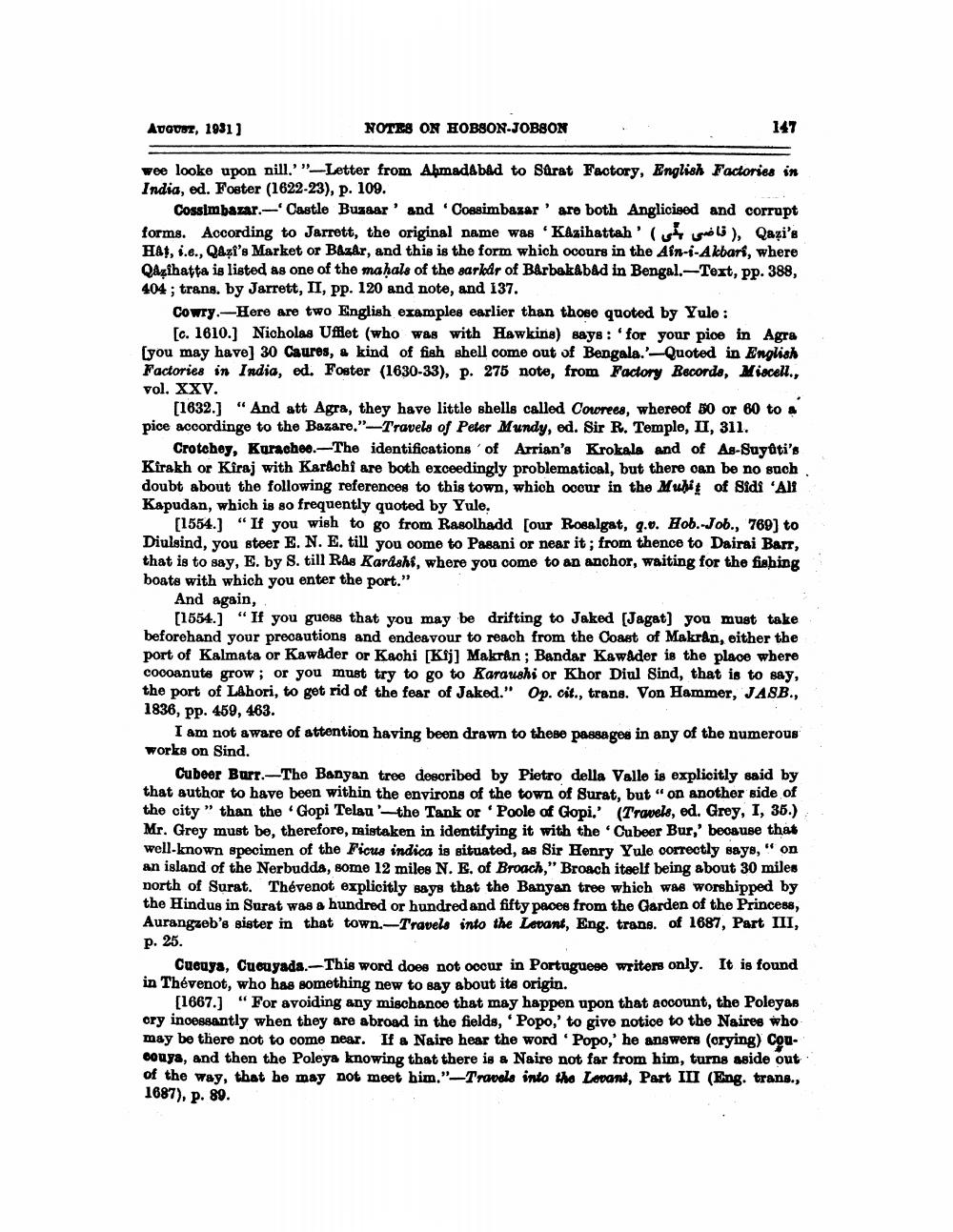________________
AUGUST, 1931]
NOTES ON HOBSON-JOBSON
147
wee looke upon nill.'"-Letter from Ahmadabad to Surat Factory, English Factories in India, ed. Foster (1622-23), p. 109.
Cossimbazar.- Castle Buzaar' and 'Cossimbazar' are both Anglicised and corrupt forms. According to Jarrett, the original name was 'Kâzihattah(), Qazi's Hat, i.e., Qazî's Market or Bazar, and this is the form which occurs in the Ain-i-Akbart, where Qazîhatta is listed as one of the mahals of the sarkar of Barbakâbâd in Bengal.-Text, pp. 388, 404; trans. by Jarrett, II, pp. 120 and note, and 137.
Cowry. Here are two English examples earlier than those quoted by Yule:
[c. 1610.] Nicholas Ufflet (who was with Hawkins) says: 'for your pice in Agra [you may have] 30 Caures, a kind of fish shell come out of Bengala.'-Quoted in English Factories in India, ed. Foster (1630-33), p. 275 note, from Factory Records, Miscell., vol. XXV.
[1632.] "And att Agra, they have little shells called Cowrees, whereof 50 or 60 to a pice accordinge to the Bazare."-Travels of Peter Mundy, ed. Sir R. Temple, II, 311.
Crotchey, Kurachee.-The identifications of Arrian's Krokala and of As-Suyuti's Kirakh or Kiraj with Karachi are both exceedingly problematical, but there can be no such doubt about the following references to this town, which occur in the Muhit of Sidi 'Ali Kapudan, which is so frequently quoted by Yule.
[1554.] "If you wish to go from Rasolhadd [our Rosalgat, q.v. Hob.-Job., 769] to Diulsind, you steer E. N. E. till you come to Pasani or near it; from thence to Dairai Barr, that is to say, E. by S. till Ras Karashi, where you come to an anchor, waiting for the fishing boats with which you enter the port."
And again,
[1554.] "If you guess that you may be drifting to Jaked [Jagat] you must take beforehand your precautions and endeavour to reach from the Coast of Makran, either the port of Kalmata or Kawåder or Kachi [Kij] Makran; Bandar Kawåder is the place where cocoanuts grow; or you must try to go to Karaushi or Khor Diul Sind, that is to say, the port of Lahori, to get rid of the fear of Jaked." Op. cit., trans. Von Hammer, JASB., 1836, pp. 459, 463.
I am not aware of attention having been drawn to these passages in any of the numerous works on Sind.
Cubeer Burr.-The Banyan tree described by Pietro della Valle is explicitly said by that author to have been within the environs of the town of Surat, but "on another side of the city" than the 'Gopi Telau-the Tank or 'Poole of Gopi.' (Travels, ed. Grey, I, 35.) Mr. Grey must be, therefore, mistaken in identifying it with the Cubeer Bur,' because that well-known specimen of the Ficus indica is situated, as Sir Henry Yule correctly says, " on an island of the Nerbudda, some 12 miles N. E. of Broach," Broach itself being about 30 miles north of Surat. Thévenot explicitly says that the Banyan tree which was worshipped by the Hindus in Surat was a hundred or hundred and fifty paces from the Garden of the Princess, Aurangzeb's sister in that town.-Travels into the Levant, Eng. trans. of 1687, Part III, p. 25.
Cucuya, Cucuyada.-This word does not occur in Portuguese writers only. It is found in Thévenot, who has something new to say about its origin.
[1667.] "For avoiding any mischance that may happen upon that account, the Poleyas cry incessantly when they are abroad in the fields, ' Popo,' to give notice to the Naires who may be there not to come near. If a Naire hear the word 'Popo,' he answers (crying) Coucouya, and then the Poleya knowing that there is a Naire not far from him, turns aside out of the way, that he may not meet him."-Travels into the Levant, Part III (Eng. trans., 1687), p. 89.




